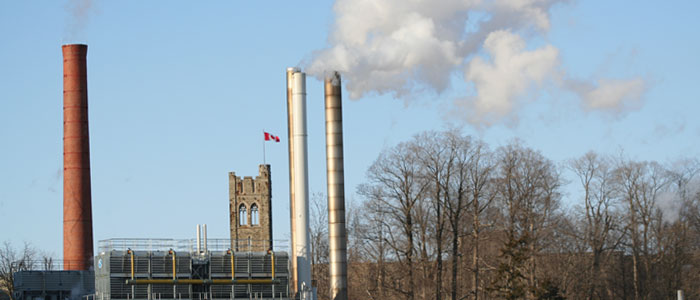Campus transitions to the heating season

October marks the Fall "shoulder season"
Every Fall, cooler than normal building temperatures can be expected at Western as a result of the seasonally variant weather. The fluctuations in outdoor conditions during the early Spring and Fall are known as the 'shoulder season' and present an annual challenge for Western’s heating and cooling provider.
When compared to the average household, the size and complexity of Western’s district heating and cooling system (from the central power plant) has significant differences. For example, a quick flick of a switch on the thermostat at home and the air conditioning kicks in. Turn it the other way and the furnace fires up. On campus however, the switch from providing cool air to buildings in the summer to warm air in the winter is much more involved. Once there is a commitment to begin heating campus buildings, for example, it isn’t feasible to reverse the process until the following Spring.
“It’s like comparing a freighter to an outboard motorboat,” say Facilities Management Communications Officer, Brandon Watson. “You can’t make sudden adjustments with such a large vessel– you must begin planning and executing well in advance if you are turning around”.
The systems are massive. Steam, for heating indoor air, is produced in the south plant. In the winter months, the boilers can push out 400,000 pounds of steam an hour to Western buildings and University Hospital – enough to heat 40 Budweiser Gardens. Chillers, which are located both in the south plant and in the basement of Natural Sciences building, produce enough capacity to cool about 5,000 homes.
Aside from the enormity of the system, the decision to switch from heating to cooling on campus relies on other factors. Weather plays the greatest role in determining the schedules. If there are still hot days, Facilities Management needs to continue to provide air conditioning. However, by waiting too long, sub-zero outdoor temperatures could sneak up on the region and damage the water filled pipes.
“Splits in the coils are problematic,” says Watson. “Depending on the rupture, whole coils may need to be repaired or replaced, putting efforts to cool the buildings again next year behind schedule.”
Another factor is the amount of time it takes to decommission one service and prepare another. Seasonal shut-down begins with cutting off the supply to the water pumps. Facilities Management Steamfitters then begin to drain the massive coils by loosening the top and bottom valves. The open system empties into the mechanical room floor drain directly below the chilling unit. A compressed air hose is mounted to the top of the unit, blasting 100 psi through the coils to remove any moisture that may still be remaining. Some of the more difficult coils can take up to a few days before they are completely dried out. With more than two hundred coils to shut down and empty across campus, the project can take up to a month to complete.
“We continue to balance protecting our infrastructure with keeping campus comfortable during the shoulder seasons,” says Watson. “I hope our clients will continue to be patient as we get the freighter turned around.”
Community members experiencing cool temperatures this fall are encouraged to contact Facilities Management at ext. 83304 or online at www.uwo.ca/fm. The concern may be seasonally related or there may be issues with the system, such as, improper control settings or fan and pump failures. The Division will maintain a record of customer calls in order to create a profile to be used to improve the system moving forward.
Fast facts
- Western has the largest district heating and cooling system in London.
- Nearly seven kilometres of steam pipe and 11 kilometres of chilled water run below the campus to provide heating and cooling to central campus.
- There are over 200 chilled water coils (for air conditioning) throughout campus.
- In most campus buildings, Western is unable to heat and cool at the same time. The system shares distribution channels and cannot pump both steam and chilled water through the same line.
- Facilities Management Steamfitters, Operating Engineers, Control Mechanics, Client Services Representatives, and Western Environmental Systems staff work together to make indoor air temperatures as comfortable as possible.
- Steam is an essential service at Western. Plant operators are running boilers 24 hours a day, 365 days a year, ensuring uninterrupted service.
